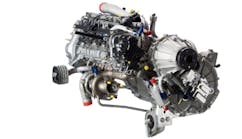Helicopter Track and Balance Theory
By Mike Robinson February 1999've heard it said on many occasions that a helicopter is several thousand rotating components trying desperately to shake themselves free of one another. In my experience, this is often a true statement, but a correctable one. A helicopter is a complex collection of rotating assemblies that allow flight characteristics unavailable to fixed wing aircraft.
Premature wear and failures in rotating helicopter components can be attributed to excess vibration levels. Reducing these vibration levels in the airframe to a minimum is absolutely essential in order to ensure the safety and longevity of the helicopter.
Rotor track and balance is the process of smoothing vibrations in the airframe, which are caused by the main rotor. The main rotor is not the only rotating assembly of concern in a helicopter; there are others such as the tail rotor assembly, drive shaft assemblies, and oil cooler fans. However, this article will address only the main rotor.
First, it is important to realize exactly what type of vibrations you are trying to reduce or eliminate. A helicopter main rotor is capable of producing vibrations in both the vertical and lateral planes.
A vertical vibration is a result of unequal lift produced by the main rotor blades. This unequal lift can be a result of blade chord profile variances from one blade to the next or improper adjustment of pitch change links and trim tabs. These constitute the most common causes of vertical vibration.
A lateral vibration is the result of an unequal distribution of mass in the main rotor "disk." This unequal distribution can be a result of the manufacturing process, which allows blade or component weight differences. Poor assembly techniques, improper alignment of a main rotor trunion, erosion, and a host of other possibilities also contribute to the situation. A lateral vibration may also be felt as a result of an aircraft that is out of "track," or vertical balance. This vibration is a result of the airframe rolling with the mass effect caused by the unequal vertical lift component.
The term "rotor track and balance" is somewhat misleading, in that "track" or "tracking" refers to adjusting the blade tip paths to make them fly in the same rotational plane. This does not always result in the smoothest ride. Some airframe and blade combinations will ride smoother with a "track split." The desired end result of the track and balance job should be the smoothest possible ride.
It is important to note that balancing is performed in the primary rotational frequency of the main rotor. There are other main rotor vibrations present, such as the blade pass frequency of the main rotor. This is referred to as the n-per-rev (n = number of blades) frequency of the main rotor. If the mechanical condition of the helicopter is suspect, these vibrations can be quite noticeable once the main rotor 1-per-rev vibrations are reduced.
As I will note throughout this article, all airframe types are not the same, and this discussion is not intended to educate the reader on the intricacies of a specific airframe. The applications discussed will be general in scope and will focus more on the general principles of helicopter rotor balancing.
A Little History
The first method employed by helicopter manufacturers and maintenance
personnel to accomplish a rotor track and balance was limited to the use of static balance equipment and tracking flags. A static balance device utilizes a "bubble" type level and balance arbor assembly suspended from a fixture to adjust the main rotor span- and chord-wise mass distribution. A tracking flag is a long lightweight pole held vertically, with two horizontal arms extending from it. Multiple strands of tape were attached between the horizontal arms, making a ribbon-like connection from one to the other. The individual main rotor blade tips were coated with different colored grease pencil or chalk. With the helicopter running on the ground, the flag was moved in toward the rotor disk. As the individually colored blade tips made contact with the tape, each left a mark corresponding to its assigned color. If the marks were vertically separated, a pitch change adjustment was needed to move the blades tips closer together. If the marks overlapped one another, no adjustment was needed. The drawbacks to this method are obvious. It was dangerous, restricted to ground only, and did not allow for track measurements in flight. The use of static
rotor balancing devices is not applicable to some aircraft.
The next solution to the tracking dilemma was to attach tip targets to the main rotor blades and visually "freeze" their flight path by use of a strobe light. This measurement could be performed for all flight speeds of interest, and is still in use today. Along with this new technology, the use of vibration sensors mounted to the airframe at specific locations was introduced. This facilitated the measurement and recording of the various vibration amplitudes in both the vertical and lateral planes. This amplitude (expressed in inches per second - IPS), combined with the phase angle (or clock angle) of the vibration, allowed the technician to manually plot corrections on a paper polar chart. The polar chart was for specific airframe use. When maintaining multiple airframe models or sub-models, each required the use of a chart relative to the specific model.
The next wave to arrive on the market saw the introduction of microprocessor-based analyzers that were capable of performing all of the balance calculations for the mechanic. Software programs developed for a specific airframe application drive these products. Along with these advances came various optical methods of acquiring track data. This allowed the user to collect track data without having to attach tip targets to the blade tips or visually interpret the position of the main rotor blades at a distance. The main drawback to the later systems is the fact that influence coefficients used in the software programs are not the same from one aircraft to the next of the same make and model.
Tools
There are many tools critical to the success of a main rotor track and balance job, the most important of which is reliable vibration analysis equipment. In today's high-technology maintenance facility, digital technology has largely replaced older analog equipment. Repair costs for aging analog analyzers is at an all-time high. A repair and recalibration can often reach half the original purchase price of the equipment. Lead-time for repairs and recalibrations can be weeks rather than days. To put it simply, new digital data acquisition systems are more economical, faster, and much more accurate. The leading digital equipment eliminates the need for strobe lights and charts, and even stores the complete job measurements for later review and printing.
Equipment Installation
Prior to acquiring data, you must first install the various vibration
sensors, tachometer signal sources, tracking devices, and associated connecting cables and mounts. The sensor types, installation locations, and material for these components have been performance-optimized by manufacturer testing and are specified in the helicopter's maintenance manual.
There are numerous types of vibration sensors available for use today. Those most commonly found in aviation applications are the accelerometer and velometer. The manufacture of the vibration equipment you are using will dictate the type of sensor required. Some systems are designed to use only one type of sensor, which limits their range of application. Modern, state-of-the-art vibration and balancing equipment allows you to configure the analysis equipment to provide power to the sensor, convert the engineering units of measure if necessary, and automatically set the amplitude scale necessary for best viewing of the sensor's output on the vibration equipment.
Generally, a vibration sensor used to perform balancing needs to be located on the supporting structure as close to the rotating component as possible. The most common location used to mount a lateral vibration sensor is the upper portion of the main transmission, where the swashplate guide base is mounted. The connector of the sensor is positioned perpendicular to the left or right of the ship's centerline. The vertical vibration sensor is normally mounted as far forward in the cabin as possible, with the connector pointed up or down, depending on the airframe. This position allows the highest sensitivity for measuring the symmetry of lift forces developed by the main rotor as blades pass over the nose of the aircraft.
The once-per-revolution (one-per-rev) source is typically a magnetic pickup mounted on the non-rotating ring of the swashplate. A ferrous metal interrupter passing in close proximity to the magnetic core produces an electrical pulse, which triggers the pickup. A photo-optical device referred to as a phototach can also produce the one-per-rev signal. The Phototach is normally located in a position that allows a beam of light to be radiated onto a small piece of reflective tape on the mast or other rotating component of the main rotor system. The light is then reflected back to an optical receiver in the Phototach lens, which triggers the electrical pulse to the analysis equipment.
Tracking devices vary in technology and limitations from one manufacture to the next. If utilizing a strobe light, it is necessary to install targets at the tips of the blades. Additionally, the strobe requires a DC power supply for operation. This power is usually tapped from the ship's power source because it cannot be supplied by portable equipment. Airframe-mounted optical trackers require the use of a mounting bracket for a solid, stable mounted position. The last and most practical option is the portable, hand-held optical tracker. This equipment requires no installation. You merely place the tracker into the cabin with the vibration analysis equipment. The tracker is hand held and operated, requires no tip targets, and operates completely from the analyzer's integrated power source.
Starting Points
Prior to starting the job, do a detailed inspection of the main rotor system and associated controls to ensure proper condition and operation. Few things are more frustrating than attempting to compensate for poor mechanical condition when performing a balance job.
If performing a periodic balance check, you need do nothing to the rotor system adjustments prior to starting. However, after major repair or overhaul work is performed on one or more of the main rotor system components, it may be beneficial to return main rotor system adjustments to nominal prior to starting the job.
Acquiring Data
After your equipment is set up, it is time to start acquiring measurements.
As a general rule, the maintenance manual will outline the flight conditions for making measurements and which measurements are required at each of these conditions. Acquiring as many data as possible will enable you to better trend and troubleshoot the vibrations at hand. As you prepare to acquire data, one important consideration is the wind conditions. No wind is the preferred condition, but if there are winds present, you should ensure that the nose of the aircraft is pointed into the wind during data acquisition. Failure to do so may result in erroneous measurements being acquired, which complicates the balance job.
The typical first step in performing a balance job is to verify the idle ground track. This is accomplished with the aircraft at idle RPM with the blades at flat pitch. The goal here is to verify that the blade paths are relatively close to one another prior to bringing the engine to full throttle. Do not attempt to eliminate small blade splits at ground idle, as this may lead to readjusting the same blade after RPM and load are increased. If the idle track is satisfactory, move to the next condition.
Once the rotor RPM is advanced, check the lateral vibration reading and the blade track again. Don't place much emphasis on the lateral balance of the aircraft at this time. If the lateral vibration is excessive, make a correction; otherwise leave this until the vertical balancing (tracking) is completed. As noted earlier in this article, changes in blade track will affect the lateral balance. Again, verify the blade track to ensure the blade paths are relatively close. If track and balance are satisfactory, move to the next condition.
Bring the aircraft to a hover into the wind. Measure both the vertical and lateral vibration levels, as well as the blade track. At this point you may place more emphasis on the vertical vibration. With the aircraft in a hover, contact with the ground will no longer influence the vertical vibration reading. Record both the lateral and vertical measurements. If the vibrations levels allow, transition to forward flight. Measure the vertical and lateral vibration levels and the tracking. When all measurements for the run have been completed, land the aircraft and determine what adjustments are needed.
Helicopter Track and Balance Theory
By Mike Robinson
February 1999
Making Corrections
When finished acquiring data, what do you do with all of the information? We have already established the two planes of main rotor vibrations
found in the airframe—vertical and lateral. Next, we will discuss how these vibrations are corrected and how to interpret the data collected.
Lateral Corrections
As described earlier in this article, a lateral vibration is the unequal distribution of mass in the rotor "disk". Manufactures have provided several methods to correct for this. The most common corrections are to place weight on the main rotor hub at specific locations, and to "sweep" the main rotor blades. Sweeping the blades can be defined as moving the blade forward or aft of its angular position. When sweeping the blades, it is safer to sweep a blade aft, as sweeping a blade forward may cause the blade to be unstable. There are airframe types that utilize only main rotor weights, only blade sweeps, or a combination of both to correct for a lateral imbalance. This correction is based on the lateral vibration measurement, either on the ground or at hover.
Vertical Corrections
As described earlier in this article, a vertical vibration is a result of unequal lift produced by the main rotor blades. There are two primary
adjustments utilized to correct for a vertical vibration. The first is the main rotor pitch change links (PCL). The PCL controls the angle of each main rotor blade individually. To move a blade up or down, lengthen or shorten the PCL for that blade. This adjustment is typically used to correct for the vertical blade separation on the ground and the vertical vibration at hover. The second adjustment available is the main rotor trim tab. To make a blade fly higher or lower, move the trim tab up or down. The adjustment of trim tabs is primarily used for in-flight corrections. Trim tabs are very sensitive, and it is important to use care and caution when making adjustments. One point to consider when making track adjustments is that as you change a blade path, you will either increase or decrease the amount of that blade's drag. This change in drag has the tendency to move the blade forward (lead) or aft (lag) of its original position. As the blade pitch is increased, drag is increased, causing the blade to lag. If the blade pitch is decreased, drag is decreased, causing the blade to lead. This lead/lag effect results in a change
in the lateral balance of the rotor disk. Thus the adage, "track affects balance" is realized.
If using the polar chart method of making corrections, you must first plot the amplitude and phase angle of the measured vibrations on the chart. Be sure you have the correct chart, as there are different charts for the lateral and vertical planes. To plot information, find the phase angle (clock) line on the chart that represents the angle of the vibration recorded, then move outward to the amplitude "ring" of the vibration and make a plot. Next, move from this plot to the correction scale at the side of the chart. This scale will determine the amount of correction required to reduce the vibration. This same plotting method applies to both vertical and lateral polar charts.
Let's look at an example of these charts. The chart above represents the vertical vibration levels measured during a run for hover (plot #1), forward flight at 60 knots (plot #2), 80 knots (plot #3), 100 knots (plot #4), and 120 knots (plot #5). As you can see, the vibration levels for hover and flight at 60 knots are relatively close together. But forward flight at 80, 100, and 120 knots are quite a bit higher. The first correction to make in this case is a target blade pitch change link adjustment of approximately one flat upward. The second correction is to make a trim tab adjustment for the difference between hover and our fastest forward flight speed of 120 knots. This correction turns out to be approximately six degrees, target blade up. A note to remember when implementing tab corrections is that as the airspeed increases, the influence a trim tab has on the blade increases also. A blade showing an increase in track split and vibration as airspeed increases will require a trim tab movement. If the vibration plots had all been in relatively the same location, only the pitch change link would have been necessary.
An important point to remember when making multiple adjustments within the same run is the fact that the influence for each of the adjustments made will be affected by the other. This is true of both vertical and lateral adjustments and can make it difficult to accurately predict the aircraft's response to a specific correction. It is easier to track the aircraft's response one correction at a time.
The last step to accomplish when finished balancing is to verify, and correct if necessary, the autorotation RPM of the helicopter.
When Should a Rotor Track and Balance be Performed?
Most aircraft manufactures have specified intervals for rotor balance checks. However, it is generally recommended that the rotor system be checked and, if necessary, balanced any time a component of the system—such as pitch links, cyclic or collective control rod ends, or swashplate—is changed or adjusted. A track and balance should also be conducted any time the pilot reports a marked change in the vibration condition of the aircraft.
Tips and Hints About Track and Balance
Rotor smoothness should be achievable in all flight regimes. Manufacturers attempt to design and certify aircraft that are smooth in all conditions.
If this is not achievable, an influencing force present in the airframe may be causing the problem. As aircraft get older, parts begin to wear resulting in higher vibration levels. When it is not possible to smooth the aircraft through all flight conditions, you may be forced to compromise and sacrifice the smoothness of one flight condition in favor of another. In this case, the flight condition where your aircraft spends the most time, or the most critical condition, should take precedence.
There are certain flags that may be noticed during the rotor smoothing process that will certainly save you the time and frustration of attempting to correct for a mechanical problem present in the rotor system. For every adjustment on the rotor system, there is an associated influence. For example, the Bell 206 main rotor head balance utilizes approximately 220 grams to correct for a span-wise imbalance of 1.00 IPS. Let's say that in the course of an otherwise normal balance job, you make a very small weight addition of 20 grams and the vibration level changes by 0.5 IPS. The "flag" in this case would be the resulting change in vibration of 0.5 IPS. This much change would, under normal circumstances, require the addition of 110 grams of weight. This should indicate that other factors are involved which may not be correctable by a normal track and balance procedure. Additionally, anytime the maximum corrections or combinations of corrections are applied without acceptable results, the mechanical condition of the systems must be suspect. The outcome is always the same. An aircraft, which is not mechanically sound, will not balance. Track and balance is not a substitute for proper maintenance or a cure-all for mechanical failures.
Finally, don't forget the human factor. If everything seems correct, but you still can't achieve the desired results, consider that you may have made a miscalculation or misadjustment in the process. It is easy enough to return the aircraft to its initial configuration and start over. Your equipment should have recorded the conditions of each run for review and verification. If values are not similar to the original data taken, a mechanical condition may exist which will prevent an acceptable result.




